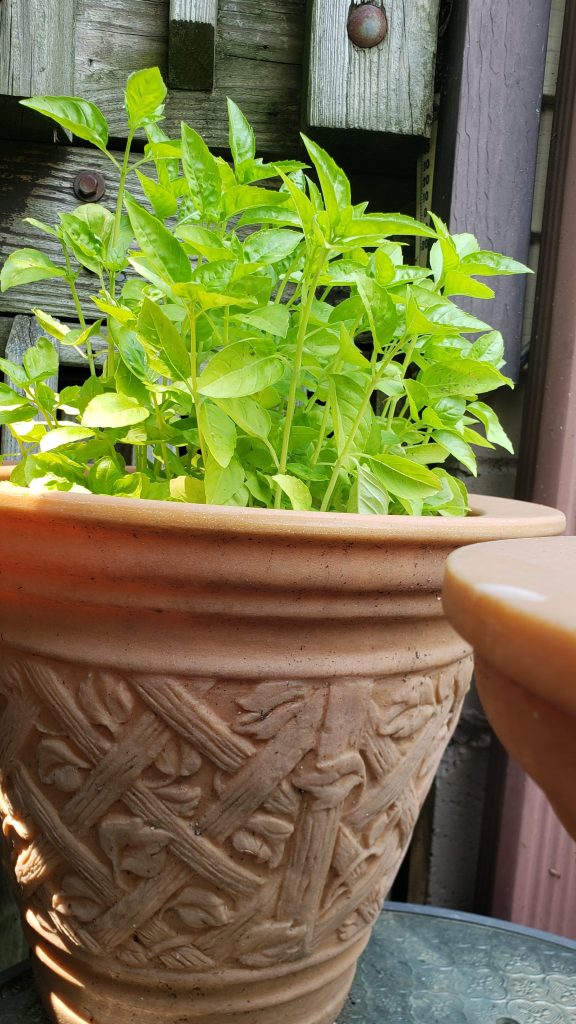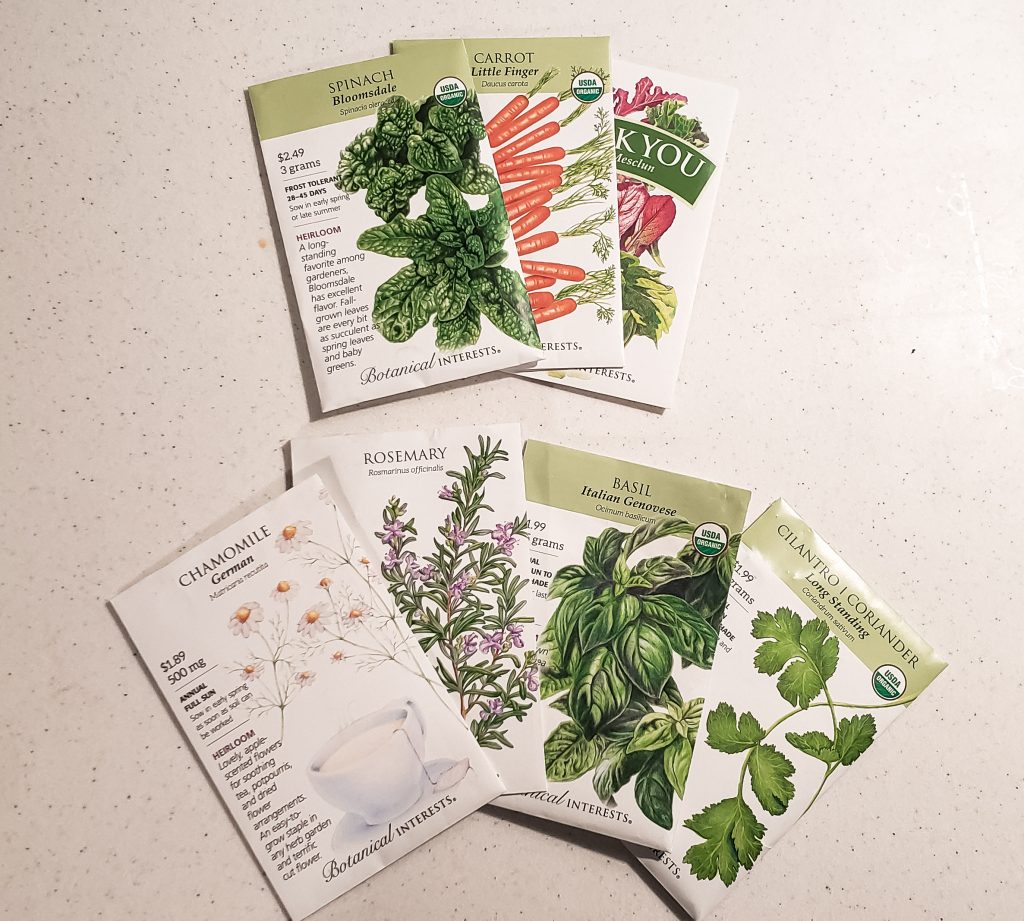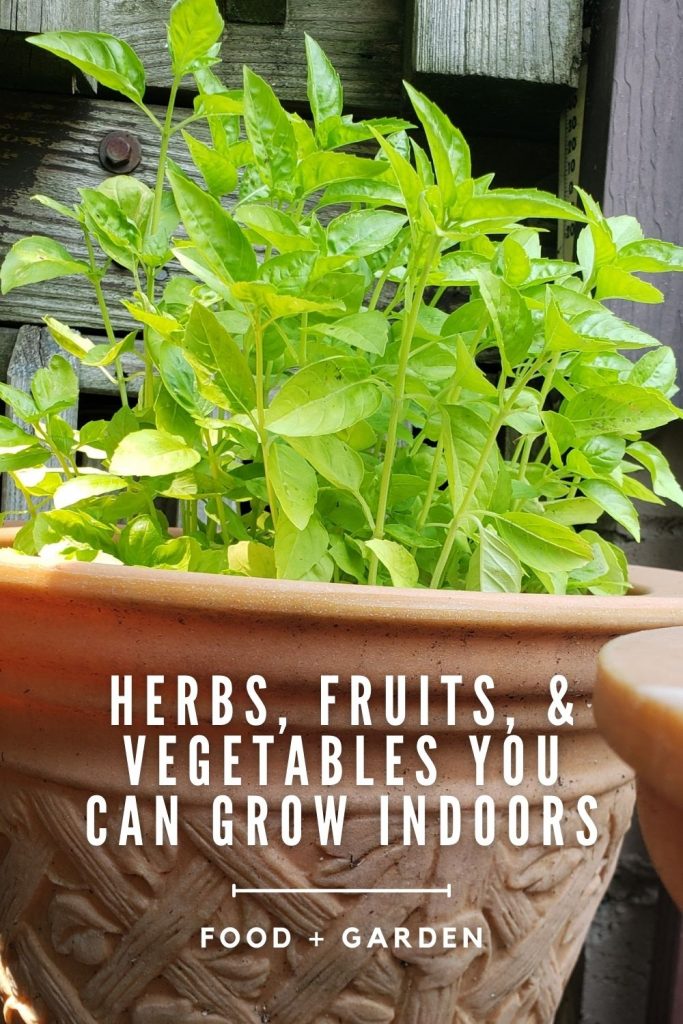Have you ever wondered what kinds of herbs, fruits, & vegetables to grow indoors? If so, hopefully this post will inspire you to try your hand at a few!

This post may contain affiliate links, which means we may receive a commission, at no extra cost to you, if you make a purchase through a link. Please see our full disclosure for further information.
Indoor Gardening
There are many reasons to try growing things indoors. For starters, you may not have any room outside to grow a garden. Or you may just enjoy having house plants that are also going to yield good fruit. Or you may be in a climate that prevents a decent outdoor growing season. Whatever the reason, there are things you can try your hand at indoors to grow your desired herbs, fruits, and vegetables.
Limitations
Of course, there are going to be a number of limitations to what you can successfully grow indoors.
- Available light
- Available space
- Room temperature
- Humidity
- Depth of pots
- Children and Pets
These limitations shouldn’t dissuade you from trying, and there are things you can do to get around many of them, depending on your living situation.
Lighting
Some ways you can mitigate the issue of light for your plants is to supplement where sunlight cannot reach your plants. There are many options in stores and across the internet for light sources for indoor gardening. These vary by size, shape, positionability (hanging/stands/etc), brightness, light spectrum, and other conditions.
You may simply have to do a little research based on your particular lighting conditions to know what would help most in your particular scenario.
For instance, our house only has windows on the north and south sides of the house, which allows very little sunlight to come indoors. It’s also a ranch style house sitting at the bottom of a hill with trees and other houses nearby, so even the sunlight that would be available otherwise simply doesn’t reach through our windows. This is a huge challenge to us in trying to keep indoor plants happy and healthy.
But perhaps you have ample sunlight from windows and many places you can place plants to keep them thriving. Just be sure that if that is not the case for you, that you look into alternative light sources that will fit both your budget and your home and plant needs.
Space and Depth
Space is going to be a consideration not just in terms of “where can I put all these plants because I want four billion,” but also because the size of individual plants will vary widely, especially when it comes to fruits and vegetables.
Consider the sprawl of a plant when you are determining what to try to grow indoors. I’m not saying it’s impossible, but you may want to skip growing zucchini or other squash varieties indoors, for instance.
Make sure that you have adequate space for your plant containers so that you have good access for watering and harvesting. Adequate space is also important for air flow so that your plants can be as healthy as possible. In general, space is one of the most common considerations for what can be enjoyable and beneficial to attempt growing indoors.
Plants also need the space for their roots to grow, aside from how tall or wide the plant gets above the soil. If your plants do not have adequate space for their rootball to form and thrive, then your plant will be weak and the chances of bearing any quantity or quality of fruit diminish significantly. Checking to be sure your plant is potted in enough soil and with enough room for expansion (even if that means transplanting a couple of times) is important.
Temperature and Humidity
It is important to consider indoor temperature and humidity for successfully growing plants indoors in the same way that knowing your climate, USDA planting zone, and general environment are when gardening outdoors.
A space that is too hot or cold, or too dry or moist for some plants to thrive will have obvious consequences on how manageable it is to grow plants indoors. With this in mind it would be a good step to check on these factors and how they trend before choosing which varieties you can grow in your home.
Children and Pets
There are several reasons that children and pets (or even guests) are a consideration for this topic. Kids and animals are likely to come into contact with your plants at some point if they live in the same house as your plants. Knowing which plants, or parts of plants, may be toxic or unhealthy for your kids and pets is important, especially with some types of herbs. Mostly we try to only grow plants that are not toxic anyway, but there are some things that we can tolerate that our dogs cannot, for instance. The same goes for kids or those with compromised immune systems.
Issues in this area can be resolved by keeping plants out of reach, or as inaccessible as possible, or by teaching older kids and guests proper plant care protocols.
As a side note it would also be beneficial to know if any of your indoor plants are a common allergen for your kids, guests, or pets.

So what can you grow indoors?
Herbs
One of the main perks of indoor herb gardening is that many or most herbs are relatively small plants. It is fairly easy to consider growing basil, rosemary, mint, oregano, thyme, chives, and even garlic in small pots on a windowsill or under some growing lights on a counter or shelf.
Many of these herbs are used in such a way that you would harvest a couple of leaves or stems at a time to use fresh, but you can also take a larger harvest to dry and flake for more perpetual usage. They continue to grow well even while being repeatedly harvested, and most herb plants are low maintenance as long as they have adequate light and water.
Fruits
It is surprising how many fruits can successfully be grown indoors, especially if you have a decent amount of space. There is a lot of potential for small bush type plants like berries. Strawberries, blueberries, and even some raspberries can be grown indoors because of their relatively small plant size and they have a relatively high yield as well.
Even more surprisingly, if you have room for a potted tree, there are even more fruit varieties that can work well indoors. Citrus trees such as orange and lemon can be potted and grown indoors with enough light. Keeping small trees indoors is trendy in some areas, so it may as well be a fruit tree that supplies you with delicious citrus while you’re at it!
Tomatoes and avocados are also technically fruits, and both can be grown indoors as well. But let’s pretend they’re vegetables, since that’s what we normally think of with these foods.
Vegetables
Many vegetables have the potential to grow indoors, but unlike herbs and even some fruit types, they often require more space, both horizontally, vertically, and in their soil space.
Vegetables that can grow indoors under the right conditions include tomatoes, hot peppers, bell peppers, root veg like radishes and carrots, and short leafy greens such as kale, spinach, and microgreens. Keep in mind that peppers especially and many varieties of tomatoes thrive at about 70 degrees Fahrenheit, so if you keep it cooler in your home than that, they may not do as well.
If you’re interested in growing vegetables like this in your home, it would be helpful to look at varieties of tomato, for instance, that have a smaller bush and do not branch out as much as most types, or do not vine as high. This helps the plant stay manageably small while still thriving and producing food.
Herbs, Fruits, & Vegetables to Grow Indoors
As you can tell, there are more possibilities for indoor herb, fruit, and vegetable gardens than you’d initially guess. This is a huge perk for people who do not live on any gardenable land, or whose apartment or HOA restricts how yard space can be used.
Indoor gardening can have a lot of potential, but I would still recommend beginning with a little bit at a time, since there is such a different learning curve to growing plants indoors instead of outdoors. Some research will be required to get it right and have a successful harvest. Begin where you’re most interested or with foods you’re most likely to eat and enjoy, or with those that have other benefits like being beautiful and improving air quality.
Once you get the hang of indoor gardening there are more things you can continue to research and pursue, especially if your interest buds from the pursuit of sustainability. Learning how to preserve by canning, dehydrating, or freezing are all good skills to acquire. Of course, learning to cook or prepare foods you do not usually use may come before such endeavors. And if you’re using heirloom seed varieties then learning to harvest seeds for subsequent growing seasons is great too – just remember that indoor conditions may mean significantly different growing seasons and plant behavior than outdoor gardening.
More Information
Hopefully the information here was helpful for a beginner doing a little reconnaissance into the idea of attempting to grow herbs, fruits, and vegetables indoors. More in depth information is available of course, but this is a good jumping off point.
If you’re interested in growing plants outdoors, or preparing for a garden by building raised beds, check out our other articles under the Food Category. We also have a free download available that walks you through how to easily (and affordably) build a 4×8 raised bed if you have the space to do that.
Happy Gardening!

